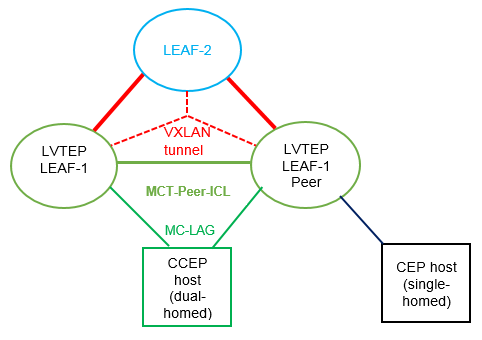EVPN-based VXLAN Layer 3 gateway on LVTEP
This section discusses the Layer 3 functionality support on such a logical VTEP (LVTEP).
The following figure illustrates a VXLAN LVTEP topology.

The LVTEP is formed through MCT peering (spoke-PW-peer) between Leaf-1 and its peer node, Leaf-12-peer, to provide redundancy for a VXLAN leaf node.
A VXLAN tunnel is created between such an LVTEP leaf and a remote leaf. The source IP address of the VXLAN tunnel is the same on both nodes. Therefore, the tunnel has a single tunnel representation on the remote leaf (Leaf-2 in the figure ). The logical connection of the tunnel is shown as the dotted red line.
The single tunnel on Leaf-2 has two underlay paths to reach Leaf-1 and the Leaf-1 peer. Any traffic southbound from Leaf-2 is load balanced and can end up in either of the LVTEP peers.
IP-MAC routes on LVTEP
Similar to the single-VTEP case, the normal MAC-IP routes are exported and installed by EVPN BGP extensions on LVTEP between the leaf nodes, providing for the following behavior:
- Only one of the LVTEP peers that learns ARP (source LVTEP node) exports the route to the remote leaf. Such an imported route is installed as a host route that is pointed to the VXLAN tunnel, which has two underlay paths.
- The source LVTEP also syncs the ARP route to its LVTEP peer over ICL as part of MCT. These routes are installed pointing to the ICL interface (PW). Such synced IP-MAC routes are not readvertised to the VXLAN peer.
- The remote leaf exports its IP-MAC routes to both the LVTEP peers, and both peers install the routes in hardware—as host routes pointing to the local VXLAN tunnel toward the remote leaf.
A BGP MAC/IP route represents L3-to-L2 mapping, which is basically ARP or ND. Static and dynamic ARP/ND entries are exported to remote PEs and get installed as host routes. IPv4/IPv6 addresses that are configured on VE interfaces are also exported.
Upon ARP learning/gleaning/snooping on a local PE, ARP/ND information is exported to its EVPN BGP peers. The information mainly includes the following: MAC, IP/IPv6, L2-VNI, L3-VNI, and ESI segment. (In VXLAN, the ESI segment ID is always 0.)
Such imported ARP/ND routes are installed or withdrawn as host routes in the hardware on the remote nodes. In the control plane they are available through the ARP suppression cache, which can be further used to reply for further ARP requests from hosts that are attached to the remote PE.
The packet path is as follows:
- When traffic bound to a remote host is received on the Ingress PE GW, no ARP request is generated, as the route table already has the hardware host entry to forward/route the traffic to the destined host. This situation prevents ARP flooding and further processing.
- Packets get routed on the ingress PE itself, and then are switched all the way to the destination host, through the egress PE. Because routing occurs on the ingress PE and switching on the remote PE, this type of forwarding is also termed "asymmetric routing."
On the nondefault VRF, the ARP/ND exports can have two subscenarios, depending on whether L2-VNI is extended on that PE or not:
- The imported IP-MAC route could be resolved against L2-VNI if L2-VNI is extended over the VXLAN tunnel, in which case the packet path is similar to the one described previously.
- If L2-VNI is not extended over tunnel on that PE, the IP-MAC route is resolved against L3-VNI, in which case the packet path followed is similar to the prefix routes path using L3-VNI.
On the default VRF, normal host IP forwarding always occurs.
L3-VNI on LVTEP
Similar to the single-VTEP case, the IP prefix routes are also exported and installed by EVPN BGP extensions on LVTEP between the leaf nodes (with Type-5 routes), providing for the following:
- LVTEP peers export the IP prefix routes over BGP EVPN to remote leaf peer(s). Such imported routes are installed as prefix routes pointing to the VXLAN tunnel, which has two underlay paths.
- The IP prefix routes are also synced across the LVTEP peers on an MCT-ICL link and are installed as pointing to the ICL (PW). Such synced routes are not advertised to VXLAN peers.
- The remote leaf exports its IP prefix routes to both the LVTEP peers, both of which install the routes in hardware as network/prefix routes pointing to the local VXLAN tunnel.
BGP IP prefix routes on VRFs are exported to the remote PE over EVPN (Type-5). The information mainly includes the following: Egress-PE-GW-MAC, IP/IPv6 Prefix route, L3-VNI, ESI segment. (In VXLAN, the ESI segment ID is always 0.)
Such imported IP prefix routes are imported to VRFs and installed as VRF routes, with the VXLAN tunnel having L3-VNI as the outgoing port and remote PE-GW-MAC as the destination MAC with in the Inner Payload L2 header.
The packet path is as follows:
- The L3/routing traffic originated on a particular VRF is terminated on the ingress PE gateway. As part of the L3 routing with in the tenant VRF on the ingress PE, the L3 packet is carried over the VXLAN tunnel to the egress PE over L3-VNI. The payload packet (L3) is always marked with the egress PE as the next-hop.
- When the packet arrives at the egress PE, the outer header L3-VNI is used as an identifier to the tenant VRF, and the inner packet gets routed within this tenant VRF context.
- Because routing takes place on both the ingress and egress PE, this is also termed "symmetric routing."

